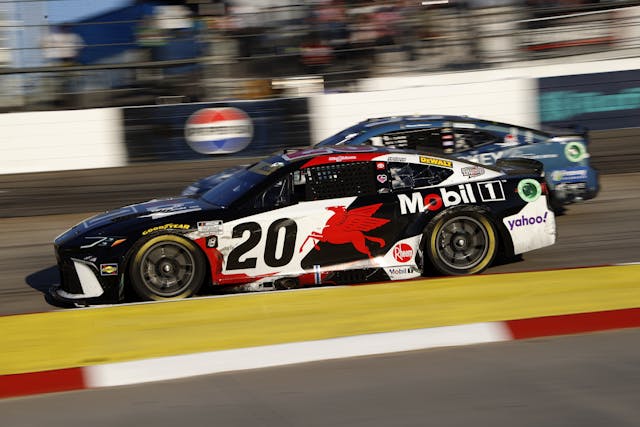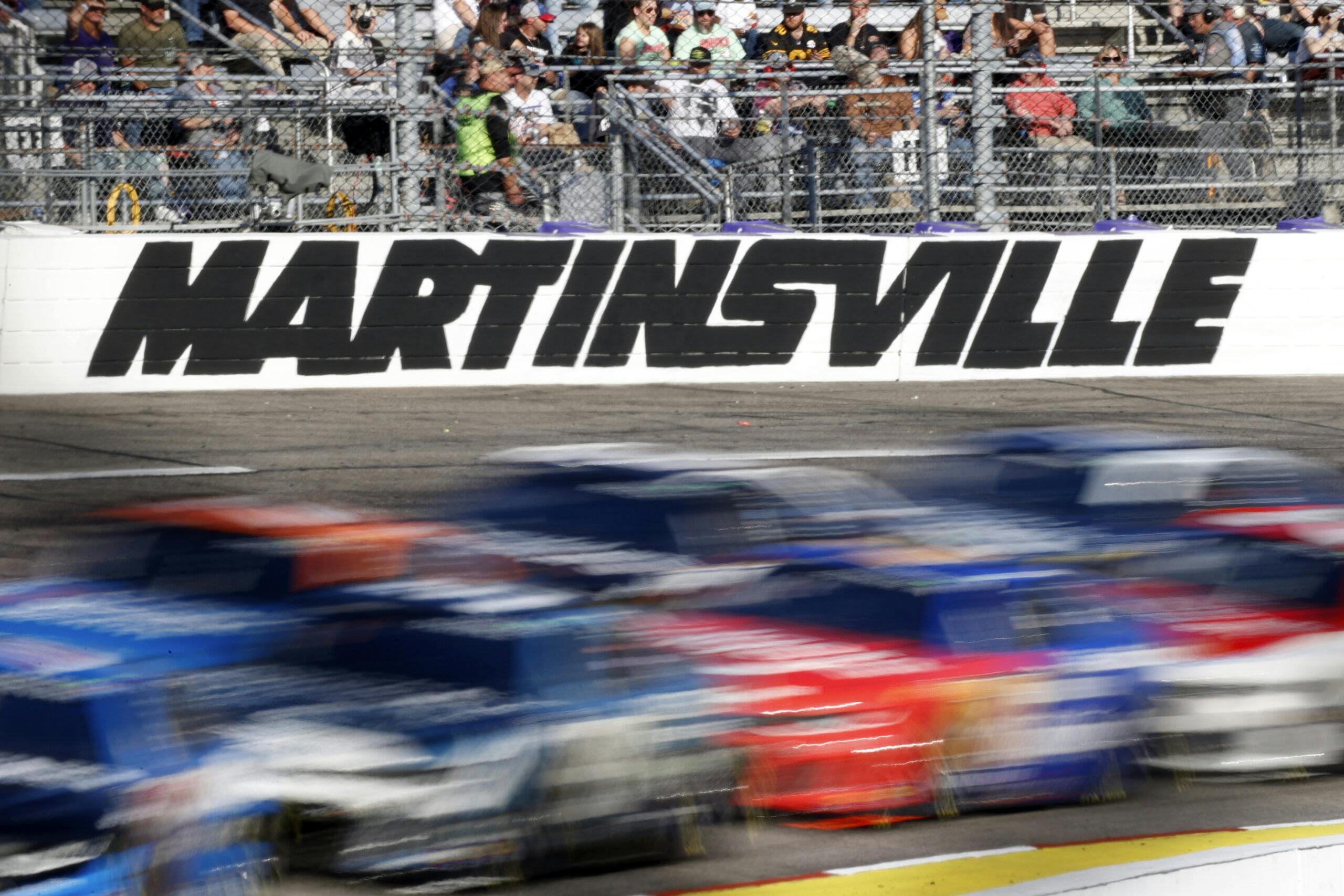Media | Articles
UPDATE: NASCAR Expected to “Drop the Hammer” with Penalties for Sunday’s Race Shenanigans
UPDATE: Late Tuesday, NASCAR penalized those responsible for the questionable actions at Martinsville Speedway. The crew chiefs, spotters, and a team executive from the teams of Ross Chastain, Bubba Wallace and Austin Dillon have each been suspended for the Phoenix race following the team’s actions as the end of the Martinsville race. Additionally, each team and driver has been fined $100,000 and assessed a 50 point penalty. The final four for this weekend’s championship finale at Phoenix remains the same. In all, $600,000 in fines were assessed. All three teams will appeal the findings.
Typically you can count on the Monday callers on Sirius/XM’s NASCAR radio channel to provide the rabid fan perspective on Sunday’s race, and this week was no exception. “It’s a black eye for the sport,” said one. “NASCAR has to do something,” said another.
It was an opinion shared by the hosts. “NASCAR needs to drop the hammer,” said Larry McReynolds, former championship crew chief.
What were they talking about? Sunday’s Xfinity 500 at the venerable half-mile oval in Martinsville, Virginia. Martinsville was the final “cutoff” race, narrowing the eligible field from eight to four drivers who still have a chance to win the season championship at Phoenix this weekend.
It’s agreed upon by almost everyone that it was an exciting race—up to the last 20 laps or so. Then… well, shenanigans.

First, let’s cover what happened last. Joe Gibbs Racing’s Christopher Bell, trying to be the fourth of the four to advance, slid up to the wall in turn four of the last lap. Unable to steer off the wall and maintain his momentum, Bell rode the wall to the finish line, just like Ross Chastain did two years ago when he gunned his engine, steered toward the wall, and used the wall to maintain his momentum through turns three and four, to the checkered flag. NASCAR had never seen anything quite like it, and let Chastain keep his finishing position, warning drivers to never do it again, ostensibly for safety reasons.
But Bell did—he sort of had to—and NASCAR penalized him multiple spots, enough to take him out of the championship hunt. Some fans didn’t like that call; others agreed with NASCAR, which took nearly a half-hour after the race to announce Bell’s penalty, and that it was not appealable.
The much more egregious aspect of Sunday’s race began earlier. Two drivers were locked in because of previous wins—Joey Logano in a Penske Ford, and Tyler Reddick in the 23XI Toyota. That left two spots: One for the winner, if he was eligible, and one on overall finishing position.

Penske’s Ryan Blaney, the current champ, won the race handily, and advanced to the final round. This left the fourth and final spot, which was going to be either Toyota’s Bell or the Hendrick Motorsports Chevrolet driver, William Byron. Had Bell been allowed to keep his finish, it would have locked out all four of the Hendrick cars, and meant there would be no Chevrolets in the final four, leaving the manufacturer with no chance to win it all this Sunday.
So Richard Childress Chevrolet driver Austin Dillon, and Trackhouse Racing’s Ross Chastain, also in a Chevrolet, blatantly threw a block behind Byron, refusing to pass him even though Byron had slowed. Passing him would have dropped him in the standings to the point where he’d be out of the hunt, and there would be no Chevys. This was bad enough, but their crew chiefs and spotters openly talked about the plan on the team radios.
Similarly, there’s radio evidence that Bubba Wallace, driving the 23XI Toyota, abruptly slowed for the final five laps to allow Bell to catch up and pass him. Which, of course, was for naught because of the wall-riding penalty.
Marketplace
Buy and sell classics with confidence
Bottom line: When opposing teams who happen to be driving for the same manufacturer gang up, rather than race against each other, it violates the NASCAR rulebook, which may gain a page or two after last weekend. As it stands now, the final four are Byron, Blaney, Reddick and Logano. But NASCAR is reviewing the radio transmissions and the video, and most everyone expects possibly crushing penalties to be delivered Wednesday or Thursday. Byron and Bell (until he rode the wall) did nothing wrong, but they benefitted by the actions of marque-mates. Will Bell and Byron be punished? It’s unlikely, but we’ll see.
After the race, NASCAR’s senior vice president of competition, Elton Sawyer said, “We’ll look at everything. We’ll get back, we’ll take all the data, video. We’ll listen to in-car audio. We’ll do all that, as we would any event.” NASCAR has something called the “100 percent rule,” specifying that drivers must give 100 percent as they race. Wallace, Dillon and Chastain were giving considerably less than that. NASCAR must also decide if pressure from Chevrolet and Toyota entered into the picture.
Meanwhile, the NASCAR Radio fan drumbeat went on Tuesday, too. “I’m ashamed,” said one caller. Said another: “If Chevrolet did this, I’m buying a Ford.”














What Chevyvdid is what the mfgs for at Daytona and Talladega. They work together pit together and push their own brands.
Wow I had a similar idea decades ago that I wanted to try at a local 1/3 mile oval: mount casters on the right side ends of both bumpers to roll against the wall. I knew then I’d never get away with it, I was already failing tech inspection for other things they were calling “too well prepared”.
NASCAR is also looking at fining the manufacturers? This has been going on in racing since the first manufacturer found the advertising value of “First on Sunday, First on Monday. The full communication between the car and team being made available across the world is what triggered this. I think this is a smoke screen NASCAR has produced to keep the lawsuit out of the public eye.
They keep on that track NASCAR will be fighting against Chevrolet, Ford and Toyota as well as the teams.
Where the manufacturers go, television will follow and we’ll have another CART/Indy Car mess. NASCAR may own all the major tracks except Indy, and we know what happened in the previous mess.
All the manufacturers have other series they can spend money in and you can bet that F1 is at the top of the list.
Liberty Media vs The France Family, the intrigue continues.
It certainly was a weekend full of rule violations. Starting with Norris and Russel pulling away during an aborted start and Mercedes ‘tyre’ pressure change in F-1. In both those cases the stewards have come to what seems to me the appropriate penalties._ Bell riding the wall may have been only a mistake. In those few split seconds flooring it might have been an almost natural reaction given where he was and what was at stake. Or it could have been a roll the dice decision.Conscious or not, it is against the rules period and no extenuating circumstances can rightfully be applied. Chastains and Dillons actions are the same but more so. Not only a violation but premeditated and with accomplices openly talking about it. When you see the replay it’s hard not to think of Justice Stewart’s comment on what should be considered pornographic saying ” I know it when I see it.” In NHRA there has always been a gentlemans agreement against double bulbing. Prestage ,wait, stage. It is actually referred to as ‘courtesy staging’. And it works. Perhaps some in Nascar might want to consider some things in a similar way for the good of all involved. If not you’ll just have to take your lumps and don’t come crying.
Anyone surprised that Chevy teams wanted a Chevy in the final?
With the money and influence of GM, I’m shocked that NACAR (no S because nothing’s stock) is doing anything. It’s the WWE of auto racing and has been for decades.
Shenanigans in a NASCAR race? I’m shocked! A never ending soap opera disguised as auto racing.
NASCAR being what they are, have created the team tactics of racing for a team or manufacture’s advantage.
What I do not understand is why anyone would get fined for such an action. Get rid of the stupid playoffs in car racing. Lets go back to system that rewards teams and drivers for season long consistency while along the way rewards and points are given for your finishing position at the end of a race and the points used to determine the CUP winner. I know it was stated that all other team sports have playoffs so should auto racing. But just because someone else does something does not me I should do it also or that it even works well. It just takes away the reason to watch any race but the last four. This is the main reason I do not watch NASCAR CUP racing anymore. This summer I attended a CUP race for the first time in many years, I attended many throughout the 90s and early 2000s thoroughly enjoyed every one and wanted so much to become a fan again. It did not draw me back in.